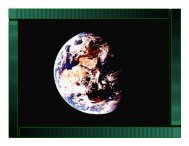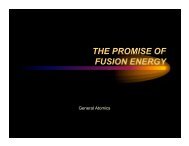Workbook: Fusion Natures Fundamental Energy Source - General ...
Workbook: Fusion Natures Fundamental Energy Source - General ...
Workbook: Fusion Natures Fundamental Energy Source - General ...
Create successful ePaper yourself
Turn your PDF publications into a flip-book with our unique Google optimized e-Paper software.
Preface<br />
This workbook is part of an educational outreach program sponsored by the <strong>General</strong><br />
Atomics <strong>Fusion</strong> Group and the U.S. Department of <strong>Energy</strong>. The overall program consists<br />
of a pre-tour video to be shown in the classroom, a half-day educational tour of<br />
the DIII–D magnetic fusion research facility located at <strong>General</strong> Atomics in San Diego,<br />
California, and post-tour materials, of which this workbook is a major part. This workbook<br />
contains an overview of the fusion process and questions related to the tour’s six<br />
educational stations providing work assignments for students after they leave the site.<br />
The overall program was developed as a<br />
collaborative effort between fusion scientists<br />
and engineers at <strong>General</strong>s Atomics<br />
and local San Diego school teachers.<br />
In developing this fusion tour package,<br />
the fusion educational team identified phenomena<br />
which are utilized in fusion energy<br />
research and which are important to a<br />
science curriculum. The tour focuses on<br />
connecting science principles taught in the<br />
classroom with phenomena used in industrial<br />
research. Buses can be provided on a<br />
limited basis to transport local students for<br />
the half-day tour.<br />
The tour begins with an initial presentation on the fusion process. Following this<br />
presentation, the students are split into small groups and rotate through six<br />
educational stations. The themes of the educational stations are:<br />
• DIII–D Tokamak & <strong>Fusion</strong> Power<br />
• Plasma: the Fourth State of Matter<br />
• Electromagnetic Spectrum<br />
• Radiation, Radioactivity & Risk Assessment<br />
• Data Acquisition and Control<br />
• Engineering Analysis, Design and Manufacturing<br />
A scientist or engineer at each station explains the phenomena to the students.<br />
Demonstrations and hands on equipment are part of most exhibits. Finally, the<br />
students are reassembled for a final question and answer session.<br />
An overview of the fusion process is contained in the first section. This is followed by<br />
six workbook sections containing questions related to fusion in general and the subjects<br />
covered in the DIII–D tour. Finally, a glossary of terms is presented.<br />
http://<strong>Fusion</strong>Ed.gat.com<br />
3<br />
QTYUIOP




